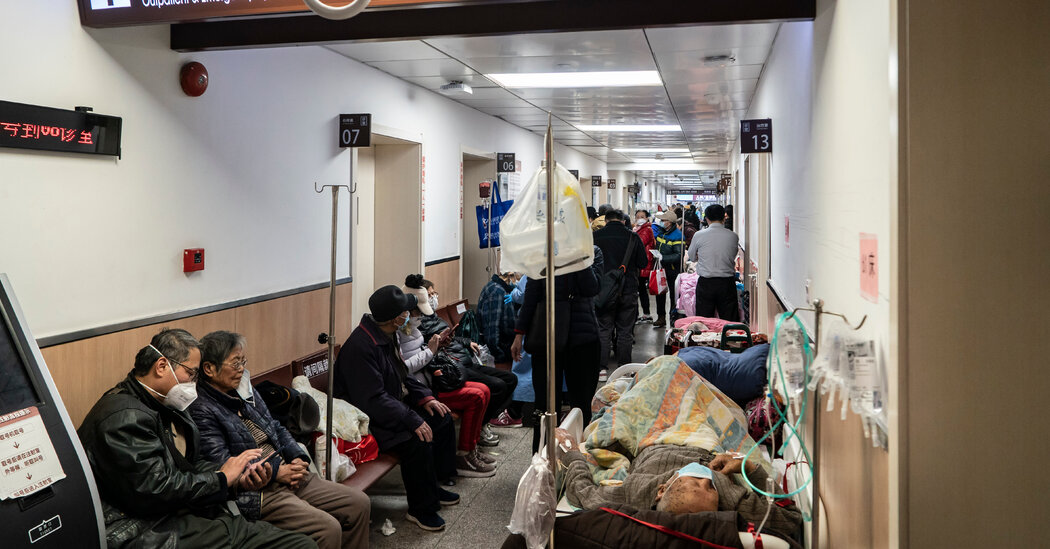
China said on Saturday that it had recorded nearly 60,000 fatalities linked to the coronavirus in the month since the country lifted its strict “zero Covid” policy, accelerating an outbreak that is believed to have infected millions of people. The disclosure was the first time China has provided an official measure of the Covid wave now sweeping the country, and represents a huge spike in the official death toll.
Until Saturday, China had reported a total of just 5,241 Covid deaths since the pandemic began in the city of Wuhan in late 2019. That measure was narrowly defined as deaths from pneumonia or respiratory failure caused by Covid. The new figure released Saturday included those who had Covid, but also died from other underlying illnesses.
China has faced mounting criticism from other countries and from the World Health Organization for not providing reliable data about the extent of its Covid outbreak and about the number of deaths across the country despite widespread scenes of overflowing hospitals, morgues and funeral homes in recent weeks.
Before the announcement, China said that only 37 people had died of Covid since Dec. 7, the day it ended its “zero Covid” policy.
The lack of transparency prompted several countries, including Japan and South Korea, to impose travel curbs on Chinese visitors after China reopened its borders last Sunday. Experts also warned that playing down the severity of the outbreak could lead people within the country to take fewer precautions.
Understand the Situation in China
The Chinese government cast aside its restrictive “zero Covid” policy, which had set off mass protests that were a rare challenge to Communist Party leadership.
China recorded 59,938 Covid-related deaths from Dec. 8 to Jan. 12, Jiao Yahui, an official with China’s National Health Commission, said at a news conference in Beijing. That figure included 5,503 people who died of respiratory failure directly caused by Covid. Another 54,435 fatalities were linked to other underlying illnesses, Ms. Jiao said.
Ms. Jiao said China was unable to release the data on Covid-related deaths sooner because it required a comprehensive examination of hospital reporting.
“We organized experts to conduct a systematic analysis on the death cases, so it took a long time,” Ms. Jiao said.
It was unclear whether the new figures mean that China has changed the way it discloses Covid deaths to include people with underlying diseases whose conditions were worsened by the virus. Officials have maintained that China’s official toll counts only those who died from pneumonia or respiratory failure caused by Covid. Other countries, such as the United States and Britain, count Covid deaths more broadly.
Experts said it was too soon to determine whether China had changed tack, but they welcomed the move to provide more data.
“We cannot make a judgment now, but it is obviously more reliable than the previous data saying there were only several deaths,” said Jin Dongyan, a virologist at the University of Hong Kong. “I hope the government will be more transparent now.”
China has narrowly counted deaths from infectious diseases for a long time, including SARS in 2003 and seasonal flu. But during the Shanghai lockdown in the spring of 2022, the authorities made an exception and used a looser definition to justify the lengthy confinement of residents. Of the 588 Covid deaths the Shanghai city government reported at that time, one was ascribed to a heart attack, and the rest to “underlying conditions” or “tumors.” Despite this inconsistency, the National Health Commission has never expunged those deaths from the national toll on Covid deaths.
Ben Cowling, an epidemiologist at the University of Hong Kong, said the actual death toll in China, like that in every country, was almost certainly higher. He said that China could have provided more reliable data on death and infection rates if it had tested hospital patients more vigorously.
“The one thing which is a bit surprising is that China has so much testing capacity but hasn’t been using it to confirm Covid in hospitalized patients,” Mr. Cowling said.
The National Health Commission’s data confirmed longstanding fears that China’s older population would be hit hard by an outbreak because so many did not receive enough vaccine doses. Of the nearly 60,000 fatalities, 56.5 percent involved someone at least 80 years old.
Covid deaths are a particularly sensitive political issue in China, because Xi Jinping, the country’s top leader, had championed a strategy of harsh lockdowns, quarantines and mass testing to try to contain the virus. Mr. Xi boasted that the model could be adopted by other countries after it proved successful in suppressing transmission early in the pandemic.
As the highly infectious Omicron variant picked up steam last year, however, that strategy became untenable. As cases steadily rose across the country, protests erupted in November as more people grew weary of the Covid restrictions. Already under major economic strain, China then abruptly reversed its “zero Covid” policy without providing an opportunity for the country to stock up on medicine.
Officials have said in recent days that infections have peaked in major cities, though concern is growing about how the current coronavirus wave will affect the nation’s countryside, which has a far weaker health care system compared with China’s cities.




